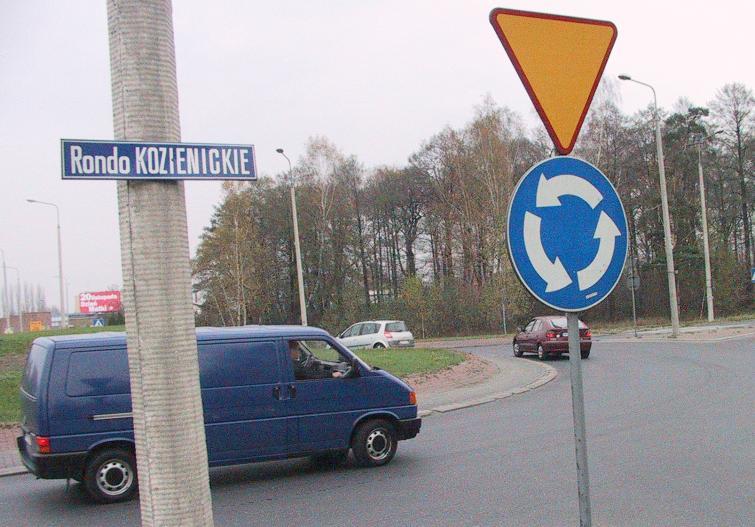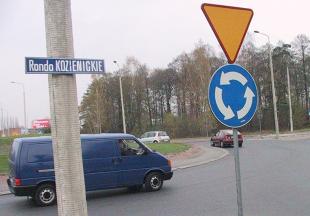
Check out how to avoid roundabouts safely - a guide
 There are more and more roundabouts on our roads, and more and more drivers pass them at least once a day. Such intersections, instead of improving traffic, sometimes cause confusion because the rules about roundabouts are imprecise. We advise you to pay attention.
There are more and more roundabouts on our roads, and more and more drivers pass them at least once a day. Such intersections, instead of improving traffic, sometimes cause confusion because the rules about roundabouts are imprecise. We advise you to pay attention.

According to the rules of the road, a roundabout is considered the same as all intersections, with the only difference being that it has a shape. There is a misconception that the roundabout applies to other rules. In fact, entering and navigating the roundabout is governed by the same rules as at other intersections. So why are roundabouts so troublesome?
Easier with one belt
The smallest one-lane roundabouts are the easiest from a driver's point of view. Most often they were built to improve security. Entering the roundabout and crossing it requires a significant reduction in speed, and its design additionally provides good visibility. The fact that we are approaching the roundabout is signaled by the roundabout sign (sign C-12) and the give way sign above it (sign A-7). Priority is given to the vehicle at the roundabout. Drivers wishing to enter a roundabout must give way to a vehicle at the roundabout.
More lanes, more problems
Problems for many drivers start at roundabouts with a large number of lanes. The main mistake is driving in the wrong lane. Meanwhile, the responsibility for finding the correct lane lies with the driver. Many of these junctions are preceded by signs indicating the permitted direction of travel from separate lanes, often supplemented by horizontal signs on the road. In such a situation, when it is allowed to turn right from the right lane and go straight, turning left is considered a violation of the rules.
What if the driver selects the wrong lane before entering the roundabout? When passing a roundabout, we may change lanes if permitted by horizontal signs on the road (dashed line), in compliance with the current rules, i.e. A driver changing lanes must give way to vehicles moving in that lane.
In some situations, lane markings make it easier for you to drive according to the rules. For example, a line delineating the inside lane, changing from dotted to solid, leads the driver from the roundabout to the specified exit, while drivers in the farthest lane are guided along dashed lines crossing the roundabout exit lane in a manner that clearly indicates that they must give way to vehicles leaving the roundabout.
Traffic lights are very helpful, especially at large roundabouts. In such a situation, drivers are obliged to obey the traffic lights, but also to follow them carefully, because the signals placed at the entrance to the roundabout do not always mean the same as the signals located at the exit of the roundabout or at the intersection. intersection with tram tracks.
Entering a roundabout - do I need to turn on the left turn signal?
If we are going to turn right at the first exit, we must signal our intention with the right sign before entering the roundabout. If we are going straight ahead, do not turn on the indicator lights when entering the roundabout. At the moment of passing the exit preceding the exit at which we intend to leave the roundabout, we turn on the right turn signal.
When we want to turn left, before entering the roundabout, we must turn on the left turn signal, and when passing the exit that precedes the exit at which we intend to leave the roundabout, switch it to the right turn signal. Many drivers do not use the left turn signal when entering a roundabout, arguing that they cannot turn straight left because if they did, they would run against the current.
At the same time, the use of the left turn signal when entering a roundabout is determined by the rules that define the roundabout as an intersection and the need to give a turn signal and change direction at the intersection (section 5, paragraph 22, of the Road Traffic Law). y this will help other road users to understand our intentions If a roundabout has a large diameter center island and the vehicle is driving a long distance in a dedicated lane, the left turn signal may be interrupted.
We remind you that the exit from the roundabout must always be signaled with the right sign.
Pitfalls and errors in roundabouts
Many, especially inexperienced drivers, are afraid to avoid roundabouts, claiming that each one looks different, often has different signage, and requires a lot of concentration to pass. Therefore, this type of intersection cannot be approached schematically.
Always pay attention to the signs and follow them. Roundabouts are a kind of trap. At such intersections, which are only marked with a “roundabout” sign (sign C-12), the rule applies that a vehicle moving on the island must give way to a vehicle approaching the roundabout.
If we meet an overly cautious driver at the intersection, do not honk and do not rush him. Let's show understanding and culture.
Even though the vast majority of drivers believe they can avoid a roundabout, collisions and rule violations are not uncommon at this type of intersection. Most often, drivers do not obey signs indicating the direction of traffic, cross solid lines that define traffic lanes, and do not give way to the priority. At large roundabouts, which are shaped to allow high speeds, collisions occur because the speed is not adapted to the road conditions. There are also people who enter the roundabout against the current.
Jerzy Stobecki
What is a roundabout?
A roundabout is an intersection with a central island and a one-way road around the island, on which vehicles must travel counterclockwise around the central island.
In typical roundabouts, the radial roads intersect with the one-way road that surrounds the island, allowing for circling. Roundabouts slow down traffic and provide drivers with a better view of other road users, thereby increasing safety. In Poland, there are roundabouts built contrary to the art of traffic management and therefore not meeting these basic objectives.
Roundabouts are sometimes referred to as road intersections and major intersections with a central island. On the other hand, it is correct to call roundabout intersections that meet the essential features of this type of structure, but which are characterized by a different organization of traffic than a roundabout.
The largest number of roundabouts in Poland, 25, is located in Rybnik. The largest roundabout in Poland, and also one of the largest in Europe, is Rondo Konstytucji 3 May in the center of Głogów, with an area of the central island exceeding 5 hectares.
Roundabout
At a roundabout marked only with a “roundabout” sign (sign C-12), the rule applies that a vehicle moving on the island must give way to a vehicle approaching the roundabout (right-hand rule), as at an intersection where priority is given to undefined characters. However, if in addition to the “ring” sign there is a “Give way” sign (sign A-7), then the vehicle moving in a circle has priority.
